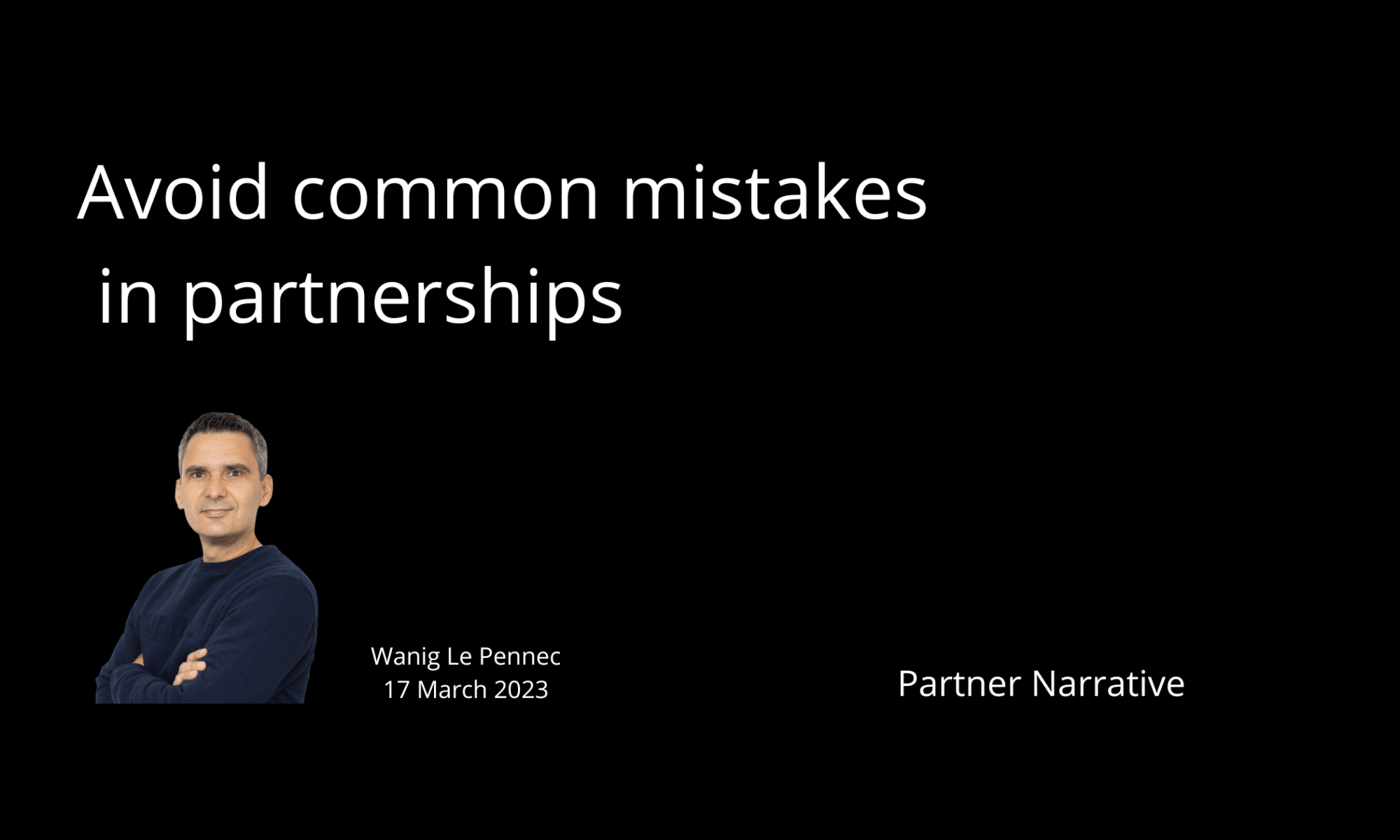During my conversations with startup founders, I often hear the following remarks: “Does partnership actually work?”, “Isn’t it too expensive and slow?”
I appreciate the feedback. Controlling costs and accelerating revenue generation are critical. As a result, before jumping on the partnership bandwagon, startup leaders must assess the risk and, if possible, forecast the ROI from partnerships.
Unfortunately, there are many examples of dry partnerships that lead to conflict and misunderstandings. You should always be prepared to walk away if a partnership doesn’t produce the expected results.
Partnerships, on the other hand, can help you increase your speed to revenue and reach your ARR targets in a more cost-effective way. But to achieve this, you need to do it right. Here are some of the most common mistakes I’ve seen in previous partnerships.
Don’t collaborate with anyone or everyone
When it comes to partnerships, the first mistake that startups make is partnering for the sake of partnering. You may sign a shiny partnership and make some nice communications. And what happens next? Partnerships are complex. They require effort and time, and you will waste a lot of time if you don’t manage them properly.
As a result, before entering into any partnership, consider the following:
- What are your objectives for this collaboration?
- What are the expected benefits?
- Is this collaboration in line with your overall strategy?
- Do you have the (appropriate) resources to invest in this collaboration?
If you can’t clearly answer these questions, don’t go into this partnership.
Moreover, A partnership with a company that does not share your objectives will be inefficient and a waste of time. If you are not aligned with the other company, then most probably, down the road, you will start losing one essential pillar of a successful collaboration: trust.
Always perform due diligence on potential partners and be selective! Does the potential partner have the same ICP (Ideal Customer Profile)? Do you share common customers? Do they have the necessary internal resources to support the partnership? Which markets do they operate in? Do they have complementary technology? Do they have a partnership mindset? Etc.
Later, you’ll notice that a small number of partners in your ecosystem generate the majority of your partner revenue. So take your time and carefully research and evaluate potential partners. Define your various partner categories thoroughly.
Don’t rush into a new partnership!
Building a relationship with potential partners can take time. Make sure your goals are in sync, and only collaborate with companies that will add real value to your company!
Again, don’t be afraid to walk away from partnerships that don’t seem to be working.
Don’t lack clarity and flexibility
When entering into a new partnership, you must clearly define what each party expects, what their duties and responsibilities will be, and how you plan to achieve your objectives. By the way, the partnership agreement that you are about to sign should definitely formalize the above.
By clearly defining the above points, you ensure that both parties are on the same page and working toward the same objectives. That way, you will avoid future confusion and misunderstandings.
Furthermore, it will help build a foundation of trust and ensure that both parties are invested in the success of the partnership.
In a survey from McKinsey “Improving the management of complex business partnerships” from March 2019, executives cited the following risks for the partnerships:
“partners’ disagreements on the central objectives for the relationship, poor communication practices among partners, poor governance processes, and, when market or other circumstances change, partners’ inability to identify and quickly make the changes needed for the relationship to succeed”.
A good way to avoid misalignment is to keep track of the results of your collaborations. I know that it may sound obvious, but it is frequently neglected. It is crucial to set clear success metrics with your partners, as well as regularly evaluate whether your goals are being met.
By measuring outcomes, you can identify areas where the partnership is succeeding and areas where it could be improved.
Tracking the outcomes of your collaborations will allow you to be more agile and adaptable. If you aren’t getting the expected results, change the way you operate the partnership: for example, update your Go-To-Market strategy, revise the incentive for the teams at your partner, etc.
Don’t expect immediate results and don’t overcommit
This is most likely my favourite. We understand that startup leaders are under pressure to produce tangible revenue results in the short term.
But partnerships can take some time to form. The results don’t come overnight.
This is especially true when collaborating with a large corporation, which may have a much longer processing time than your startup.
Instead, it is critical to look at the partnership in the long term and focus on developing a strong relationship with the other company. This may require patience and persistence, but it can result in significant long-term benefits.
Don’t overcommit. Overcommitting can result in you being unable to meet your obligations or keep your promises.
As a result, it is critical to be realistic about what you can offer and to define clear expectations with the partner company. This will help to ensure that both parties are on the same page and that the collaboration succeeds.
In his book “The Art of Strategic Partnering – Dancing With Elephants”, Mark Sochan mentions how important it is to set realistic expectations:
“unrealistic sales goals can pose a real problem for both sides. The smaller company most likely banked on how much revenue would be generated. The larger company might have convinced other senior executives in the enterprise to support the deal, based on a much larger number of additional units predicted to sell.”
Mark Sochan
This also applies to the internal partnership teams and the way they communicate internally. When communicating with executives, the partnership team must set realistic expectations.
Don’t forget to ask how you can help
Do you want a fruitful collaboration? Don’t just think about yourself! Partnerships are also about giving and sharing.
Take a moment to consider your partner’s goals. Then, inquire as to how you can assist them. Proactive partnership professionals understand the importance of mutual support. By giving and sharing, you can demonstrate a genuine interest in your partner’s success. Again, partnerships are about developing personal relationships founded on trust.
Partnerships are also about reciprocity. Make sure your own company is ready for partnerships by having the right internal culture to establish collaborations based on trust and transparency. This passage from the book of Matt Bray “The Partnership Principle: A 180-Day Guide For Revenue Leaders Growth Through Collaboration” says it clearly:
“when acquiring partners concern yourself with optimising what partnering with your organization, business culture, and values looks like. Take a good look at your own organization. How do other companies perceive you and your reputation? What do your employees say on Glassdoor? How does your organization project values, belief and trust? Find like-minded partners who can re-ciprocate; who could be a cultural fit and have processes in place for trust and transparency to flourish.”
“when acquiring partners concern yourself with optimising what partnering with your organization, business culture, and values looks like. Take a good look at your own organization. How do other companies perceive you and your reputation? What do your employees say on Glassdoor? How does your organization project values, belief and trust? Find like-minded partners who can re-ciprocate; who could be a cultural fit and have processes in place for trust and transparency to flourish.”
Matt Bray
So, make sure to build your own internal culture of collaboration, trust and transparency, and don’t hesitate to ask your partners how you can help!
In conclusion, as a startup leader, you can achieve your goals faster and cheaper through partnerships. But don’t fall into common traps. Follow the above recommendations and you’ll pave the way for successful and mutually beneficial partnerships.


